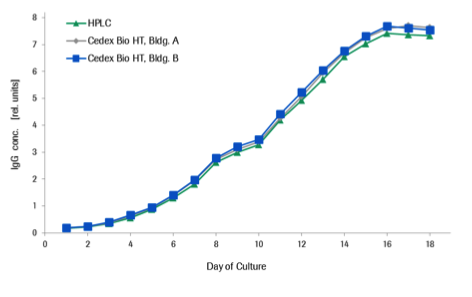
Measuring IgG Titer: Need for Real-Time Results, Customization and High Comparability to HPLC
Introduction
The successful implementation of PAT (process analytical technology) involves analysis and monitoring of key attributes within the bioprocess. When measuring critical process parameters, such as IgG titer, the need for high quality data AND real-time access are very important.
- While HPLC is the gold standard, is it accessible at all stages (early cell line development to manufacturing) and at the frequency desired?
- What is the impact of getting IgG titer in minutes versus days, without preparing and sending samples for HPLC analysis?
]Roche Custom Biotech offers an IgG assay available on the Cedex Bio and Cedex Bio HT Analyzers which provides fast and accurate measurement of human IgG in cell culture and fermentation media and delivers results that are highly comparable to HPLC (see Graph 1). The assay is based on a turbidimetric method using antibodies directed against the common human Fc region. Additionally, the assay calibration can be adapted specifically to the individual IgG molecule, providing optimal accuracy for artificially engineered antibodies with uncommon structures as well. When compared to gold standard methods like HPLC, the data shows close correlation with decreased turnaround times and less need for manual intervention.

The Cedex Bio and Cedex Bio HT Analyzers provide access to 21 assays including Glucose, Lactate, Ammonia, Glutamate, Glutamine, LDH, IgG, Iron, Acetate, Phosphate, Optical Density, etc, and a test menu that has continuously expanded according to the needs of the market. The systems offer on-board dilution, minimal hands-on maintenance, low sample volume requirement and wide measuring ranges. The Cedex Bio Analyzer is appropriate for low to medium sample throughput while the Cedex Bio HT Analyzer is suited for higher throughput holding up to 90 samples at once (with continuous loading), and offering advanced workflow integration capabilities.
Measuring IgG Titer: Need for Real-Time Results, Customization and High Comparability to HPLC
Dr. Christian Weilke, Ph.D., International Product Manager at Roche Custom Biotech, will be answering your questions regarding the IgG assay and the Cedex Bio and Bio HT Analyzers. Christian holds a Ph.D. in chemistry and joined Roche in 1999. Since 2010, he has been working in Custom Biotech holding several different positions, and is currently responsible for the Pharma In-process Control portfolio.
Question 1
Is there a version of this system that is suited for measuring microbial fermentation samples?
The Cedex Bio Analyzers with their comprehensive test menu are perfectly suited for in-process control of cell cultures and bacterial and yeast fermentation as well, on the same system. Adding new assays to your instrument is simple and just requires to load in the test settings from a barcode in the pack insert. There are currently 21 tests available for the Cedex Bio Analyzers. Several tests are more relevant for monitoring of microbial fermentation such as: Optical Density, Acetate, Glucose, Ammonia, Phosphate, Sucrose, Glycerol, etc.
Question 2
How do you customize this assay for different IgG molecules?
The Roche IgG Assay can be adapted to specific human IgG molecule(s) by a product-specific calibration. We provide a protocol where the Roche calibrator can be replaced by a sample of your individual IgG molecule with a known concentration, and the rest of the assay reagents are fully compatible, with no additional materials or hardware needed. Both the Cedex Bio Analyzers are capable of storing multiple custom calibration curves, allowing flexibility to expand the customization to obtain titers for multiple products.
Question 3
What sample preparation is needed for the IgG determination?
There is no sample preparation needed. Cell culture suspensions can be applied directly to the analyzer for running the IgG assay. For sample storage, it may be preferable to remove the cells by centrifugation, in order to prevent changes of the concentrations of ingredients.
Question 4
How does this monitoring impact sterility of the process?
The Cedex Bio and Bio HT Analyzers are standalone systems and therefore do not impact sterility as you can use your standard process to collect samples from your bioreactor in a sterile way. The samples can then be loaded directly onto the Bio or Bio HT Instrument, or if preferred cell free samples can be prepared. Additionally, the Bio HT can also be integrated in an automated at-line sampling and analytics solution, such as the Flownamics Seg-Flow system for sample management.
Question 5
With the Cedex Bio or Bio HT how often can I take samples/measurements?
Both the Cedex Bio and Bio HT offer continuous sample loading and can run 1 assay, such as IgG, or any combination of the 21 available assays. The Cedex Bio HT is ideal for use in labs requiring high throughput; it holds up to 90 samples at once, with continuous loading. The system can operate un-interrupted, and as an example, can process up to 320 IgG samples per hour. The Bio is better suited for a lower throughput application; it holds 8 samples at once, with continuous loading, and can provide 60 results per batch.
Question 6
We are running perfusion culture so our runs are over a month long. Can the inline sampling be adapted for that kind of timeframe?
“At-line testing” using the Cedex analyzers requires you to obtain a small amount of sample (minimum of about 100 µl) from the culturing system for testing. The big advantage in comparison to an integrated in-line system is that an alteration or failure of an internal sensor in the bioreactor would be fatal because process control is no longer possible (severe process risk). On the other hand, the at-line instrument can be easily maintained and you can rely on continuous process control with high data quality, and the instrument has the flexibility to be placed in close vicinity to the culture or in a dedicated lab, whatever fits better in the individual environment.
Question 7
What is the detection limit for low concentration? And what kind of sample size do you need.
The Cedex Bio Analyzers provide selectable test protocols for automated IgG determination with high sensitivity down to 10 mg/L and up to 8 g/L. Using the instruments on-board capability for further pre-dilution of the sample, the range can be extended to 40 g/L (when taking advantage of this feature, checking the validity of the results for your individual sample matrix is recommended).
The IgG assay requires only 2-25 µL of sample (for sensitive or high range). A 100 µL sample volume is sufficient to perform the IgG assay and also additional assays from the test menu, such as: glucose, lactate, glutamine, LDH, NH3, etc.
Question 8
Can you measure multiple parameters with one sample?
You can measure any combination of the 21 available tests from one sample, with the flexibility to have profiles with specific test combinations or to run a different test combination on each sample. For the majority of possible combinations of less than 10 tests, one small sample volume of 100 µL is sufficient, as most of the tests use only 2 µl of the sample. For more complex testing, with higher numbers of tests or different programmable sample pre-dilutions, a sample volume of about 300 µL would be recommended.
Question 9
Does the IgG need to be purified before analysis?
There is no sample purification or preparation needed. Cell culture samples can be loaded directly into the Cedex Bio or Bio HT analyzer to perform the IgG quantification. A separation from the cells is not required for the IgG measurement, nevertheless, for sample storage the separation is recommended to prevent alteration of the sample composition.
Question 10
If HPLC is the gold standard what are the advantages of the Cedex?
For some of the relevant analytes in bioprocess control (Eg: IgG or amino acids), HPLC enables a very accurate analysis, but requires:
· Highly trained and experienced operators
· Suitable standard materials from another source
· A specialized lab environment (HPLC is not executed at-line near the bioreactors)
· Manual sample preparation (filtration, protein precipitation, etc), which takes time and can be error-prone
· Delayed time to result (up to several days!) due to the need to send samples to a separate analytics lab
The Cedex Bio and Bio HT analyzers provide results of high accuracy, comparable to the more laborious "gold standard" methods like HPLC with added advantages including:
· Availability in the direct environment of the bioreactors
· Providing results within minutes
· Don't need any sample preparation, cell culture samples can be placed directly on the analyzer
· Can be operated by any lab technician, after a short training of the basic functions
· Offer a comprehensive and expandable test menu, and all required materials are provided by Roche
Question 11
What is involved in cleaning/validation of the equipment. Also what are the maintenance requirements?
Both the Cedex Bio and Bio HT analyzers are robust systems requiring very little maintenance. The Cedex Bio analyzer requires only 10 minutes of daily hands on maintenance and there are a couple routine cleaning activities that need to be performed on a weekly or monthly basis which take an average of